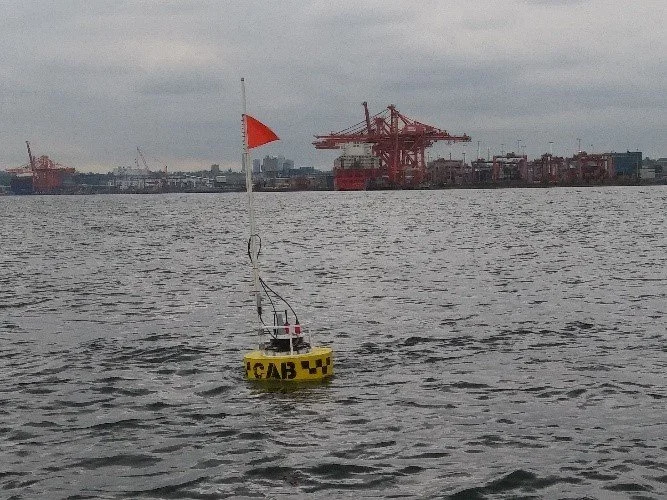Reducing noise impacts on at-risk whales: SMRU Consulting growing the North American team to meet global challenges
This year has been a challenge to us all. With a global pandemic and resulting “Anthro-pause”, social unrest, and work-from-home woes, this will be a year for the records. However, despite all this we at SMRU Consulting North America are pleased to have added five new staff members to our ranks. All five scientists are involved with projects that aim to reduce negative noise impacts on whale species at risk.
Bio-acoustician Dr. Kaitlin Palmer joined the Canadian office after a post doc at San Diego State University and has already been involved in projects on both coasts, including modelling detection ranges of Right whales for offshore wind construction mitigation, and classifier development. Kaitlin also jumped into joining our various collaborative studies with the Port of Vancouver’s Enhancing Cetacean Habitat and Observation (ECHO) Program.
As part of one ongoing ECHO study, we worked with our Tsleil-Waututh Nation partners to learn more about underwater noise and cetaceans in Vancouver’s inner harbor, called Burrard Inlet. For this project we had two goals. First monitor ambient noise levels throughout the harbor and second, characterize the source levels for large vessels in the area including container ships, cruise ships, and passenger ferries such as the SeaBus and also sea planes. For the first goal we used five acoustic recorders called Soudtraps deployed throughout the inlet for a one-year period. We used two of own designed and built real-time coastal acoustic buoys (CABs) to record source levels .
Deploying Soundtraps and CAB in Burrard Inlet
A report on this baseline noise monitoring work is available on the ECHO website.
We highlight a 30 dB (or 1000 times more intense) difference between hydrophone locations in Burrard Inlet West (Vancouver’s main terminal locale) compared to a nearby Fjord called Indian Arm, that sees only small recreational traffic. We documented clear positive acoustic benefits of berthed vessels moving to shore power and surprisingly high noise levels (188 dB) from a berthed cruise ship using an ultrasonic anti-fouling system.
Alex Harris joined the Canadian team in May, after completing his Masters degree at Simon Fraser University. He started on two interesting project, crunching data on killer whale passive acoustic monitoring and strike risk forecast models and is now also leading the current fieldwork operations in Canada, including the continuation of Burrard Inlet ambient noise study through its 2nd year. The ECHO-led voluntary ocean-going vessel slowdown in Haro Strait (and now Boundary Pass) has just completed its fourth year and the team are collating the necessary tidal, weather, AIS and small boat presence meta-data to be able to report to the ECHO stakeholders on the sound level reductions resulting from the vessel slowdown in this area. A second vessel slowdown around Swiftsure Bank, a newly identified area of high Southern Resident killer whale use, also achieved good participation this summer.
Current threat reduction actions and scientific research to help recover the endangered population of 74 Southern Resident killer whales (SRKW) is unprecedented and this trans-boundary effort continues to increase. Everyone here has their fingers crossed the newest calf (j-58) is a female and new mums J35 and J41 have a successful winter finding their salmon prey. You can listen in real-time for killer whales, humpback whales and the underwater sounds of the Salish Sea using a link to our hydrophone based at Lime Kiln State Park
Just across the border in the Washington State, Paul King has joined us as systems engineer and is managing the CABOW (Coastal Acoustic Buoy for Offshore Wind) project. A seasoned Computer Scientist and Electronics Engineer Paul brings both technical expertise and project management skills to our team. CABOW is a 3-year U.S. Department of Energy and Maryland Department of Natural Resources project to protect North Atlantic Right Whales from the effects of pile driving during the construction of offshore wind farms. Like SRKW, North Atlantic Right Whales have many threats and cumulative effects are a major concern. Happily, 2020 saw far fewer mortalities than recent years.
Jessica Thompson joined the San Juan office as junior scientists late last year. Jessica comes to us from NOAA Northwest and is an experienced MMO. She is involved in acoustic verifications of porpoise clicks as part of a tidal turbine monitoring project and is also part of the field deployment and CAB production team. Sam Tabbutt is the newest member of the US team and adds to our Field Engineering strength with his background in physics and mathematics. Sam joins us from the Cape Eleuthera Institute in the Bahamas where he helped further their turtle research. Jessica and Sam’s main focus, is to build, test and optimize the performance of the current generation of CABs, as well as the next generation CABOWs, which moves the main computing unit to the sea bottom, but retains real-time communications capability through a surface tele-buoy.
For the last year, reliability testing has included multiple CABs monitoring small boat noise and killer whale detections on Salmon Banks, and a San Juan County voluntary no go zone.
There are a lot of challenges deploying and maintaining a real-time hydrophone buoy, including moorings; power; communications; QA/QC on cetacean detection; ambient noise reporting statistics; and remote onboard control options. Despite this, we exceeded 93% uptime on this project.
One of the most exciting features of the new CABs is the ability to classify right whale calls using advanced machine learning as well as provide some localization information. We have also increased the endurance and robustness of the units to best meet the needs of offshore wind developers, aiming to provide a unit that can be deployed with minimal machinery but provide consistent acoustic coverage over weeks or months of wind farm construction. The CABs performance in Atlantic waters will be further tested and validated as part of the US DOE CABOW project next year. Happy Holidays.





